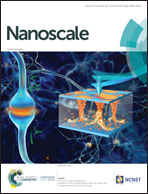Intrinsic limits of defect-state photoluminescence dynamics in functionalized carbon nanotubes†
Abstract
Defect states introduced to single wall carbon nanotubes (SWCNTs) by covalent functionalization give rise to novel photophysics and are showing promise as sources of room-temperature quantum emission of interest for quantum information technologies. Evaluation of their ultimate potential for such needs requires a knowledge of intrinsic dynamic and coherence behaviors. Here we probe population relaxation and dephasing time (T1 and T2, respectively) of defect states following deposition of functionalized SWCNTs on polystyrene substrates that are subjected to an isopropanol rinse to remove surfactant. Low-temperature (4 K) photo-luminescence linewidths (∼100 μeV) following surfactant removal are a factor of ten narrower than those for unrinsed SWCNTs. Measured recombination lifetimes, on the order of 1.5 ns, compare well with those estimated from DFT calculations, indicating that the intrinsic radiatively-limited lifetime is approached following this sample treatment. Dephasing times evaluated directly through an interferometric approach compare closely to those established by photoluminescence linewidths. Dephasing times as high as 12 ps are found; a factor of up to 6 times greater than those evaluated for band-edge exciton states. Such enhancement of dephasing and photoluminescence lifetime behavior is a direct consequence of exciton localization at the SWCNT defect sites.



 Please wait while we load your content...
Please wait while we load your content...
